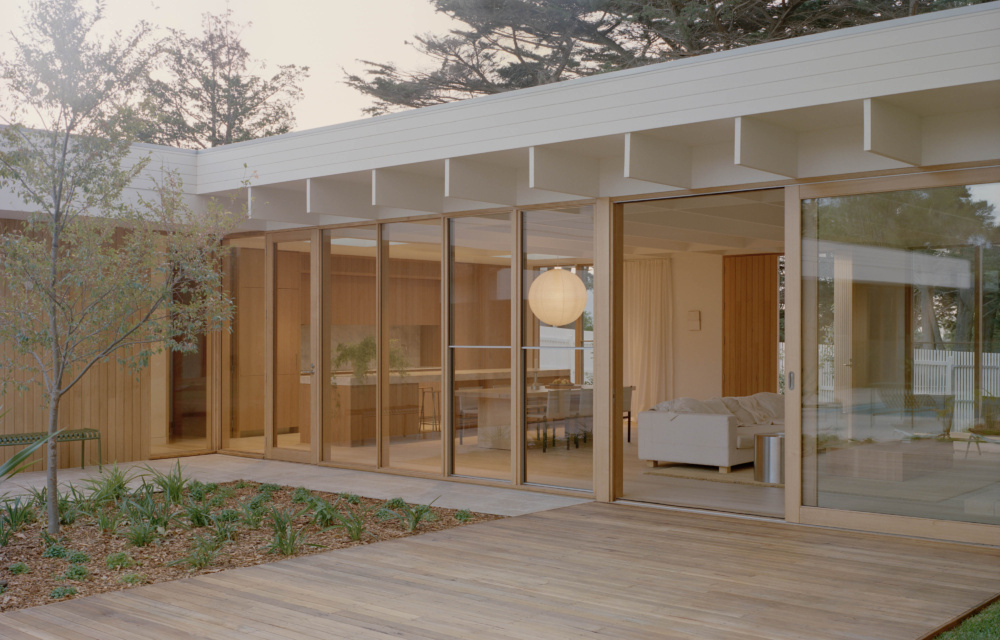A Modern Interpretation Of A Classic Mid-Century Beach Shack
Architecture
This new Mount Martha beach house by Victoria Merrett Architects balances the historical vernacular of the area with the needs of a modern family.
Dimple wall light by RBW.
The exterior features iron ash timber cladding and white-painted laminated veneer lumber (LVL) rafters, complemented by a weatherboard fascia for a covered eave.
Materials were chosen for their durability, cost-effectiveness, and timelessness.
Rice Paper Shade Large pendant by HAY. Dining table by Mark Tuckey. Mastro Chairs by Afra and Tobia Scarpa from Castorina. Sofa by Moroso with Diesel. Candle holders by Fabien Cappello.
Rice Paper Shade Large pendant by HAY. Dining table by Mark Tuckey. Mastro Chairs by Afra and Tobia Scarpa from Castorina. Candle holders by Fabien Cappello.
Strong connections to the outdoors encourage time spent together in the garden and around the pool.
Tapware from ABI. Stone from Signorino. Floor tiles from Eco Outdoor. Floorboards from Woodcut. Palissade Sun Lounge by HAY.
Stone from Signorino. Floor tiles from Eco Outdoor.
The completed home provides the family with flexible, light-filled spaces that adapt to their daily routines and entertaining guests.
Creating a home grounded in its coastal context and timeless in its design were the key drivers of this Mount Martha project, on Victoria’s Mornington Peninsula.
The new house needed to respect the area’s history of modest, well-crafted beach shacks, while responding to the needs of a modern family.
Key priorities included generous living areas, a strong connection to outdoor spaces, and plenty of storage.
‘The clients were clear about wanting a home that felt open and light-filled, but also private and practical, with dedicated zones for family life and entertaining,’ says Victoria Merrett, director of Victoria Merrett Architects.
Victoria Merrett Architects designed the new house, which balances utility and warmth, with materials and forms that nod to the local vernacular — executed in a contemporary manner.
Materials were chosen for their durability, cost-effectiveness, and ability to achieve this timeless aesthetic.
The exterior features iron ash timber cladding and white-painted laminated veneer lumber (LVL) rafters, complemented by a weatherboard fascia for a covered eave.
The interiors continue the use of painted LVL rafters paired with timber veneer, stainless steel, a mix of emerald quartzite and white-grey marble, and simple white mosaic tiles.
To achieve a greater sense of ‘lightness’ in the living space, Victoria Merrett Architects devised a clever solution.
Victoria explains, ‘We wanted to eliminate the beam above the windows that would typically support the rafters, aiming instead for the rafters to appear as though they were being supported/resting on the window frames… To create the illusion that the windows themselves were structural, lending the elevation a floating, airy quality by removing a visible layer of structure.
‘Working closely with our structural engineer, we devised a solution where rather than having the rafters bear directly on the windows, we designed a concealed structural system within the roof space above. This allowed the rafters to be suspended from above, enabling us to maintain uninterrupted glazing, and flood the interior with natural light.’
The home’s L-shaped floor plan is oriented and configured for optimal passive solar performance, further maximising natural light and encouraging cross ventilation to reduce the need for artificial heating and cooling.
Construction was streamlined utilising a modular grid system, which saw the project designed and built in a relatively short 16 month period.
Victoria’s favourite part of the home is the simple yet impactful use of materials.
‘We were able to create a strong visual presence using a restrained palette with a simple modular system, which gives the house a sense of calm,’ she says.
The completed home provides the family with flexible, light-filled spaces that adapt to their daily routines and entertaining guests.
Strong connections to the outdoors encourage time spent together in the garden and around the pool, while the layout allows for privacy.
‘It’s a house that makes everyday living feel easy and enjoyable, and that will continue to evolve with the family’s needs,’ Victoria says.

